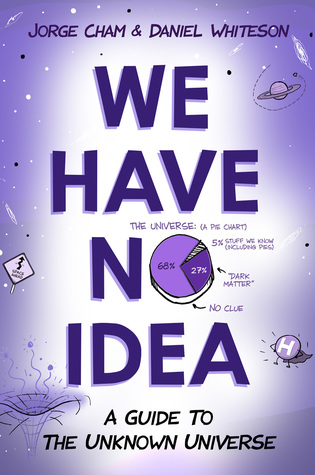
On the inside flyleaf of We Have No Idea, it states:
Armed with their popular infographics, cartoons, and unusually entertaining and lucid explanations of science, (Jorge Cham and Daniel Whiteson) give us the best answers currently available for a lot of questions that are still perplexing scientists, including:
• Why does the universe have a speed limit?And after finishing the book, I can't help but observe that these four particular questions are among the many that the authors are unable to answer: We simply don't know. They don't give us many answers at all, but they do ask a fascinating string of questions that are revelatory in their unanswerability. The science here is easy to understand (all anecdotal, no math) but I could have done without the unending puns and quips (especially annoying when 95% of 129 footnotes are distractingly lame jokes; I would have skipped them all if it weren't for the 5% that were relevant). As I was reading I kept wondering, "Are the jokes ruining this for me?", but I guess they did serve to keep everything easy and accessible: this is pop-science-light; appropriate for a lay-reader like me but unlikely to be of use for the rocket surgeons out there.
• Why aren't we all made of antimatter?
• What (or who) is attacking the Earth with tiny, superfast particles?
• What is dark matter, and why does it keep ignoring us?
I do read some science books, but there's a lot in We Have No Idea that I haven't heard before. As that bar chart attempts to illustrate, the matter that we are able to describe and interact with only comprises 5% of the “stuff” of the universe. We know that dark matter makes up another 27%, but while we can observe its effects on a cosmological scale, we can't see it or understand what it is. That leaves a whopping 68% made up of dark energy – something we can neither observe or understand but which we know must exist because it explains the present-day expansion of the universe (which is why it's called “energy”, even if it's not energy as we would know it) and every mathematical proof confirms that there's 68% of something missing from our observation-based models. When I went to high school, there was a whole gang of subatomic particles that seem to have become irrelevant: We now know that everything we observe is made up of only electrons, up quarks, and down quarks; and while there are nine other subatomic particles, they're weird and we don't know what they do. I thought I understood the concept of mass, but it's weird, too:
• It's weird because the mass of something is not just the mass of the stuff inside it. Mass also includes the energy that binds the stuff together. And we don't know why that is.I like the idea that superfast cosmic rays are constantly bombarding us that must be coming from “a new kind of object in the universe that we don't know about” (and that the authors would like you to use your personal devices as cosmic ray detectors while you sleep, info here). And I like all the quirky coincidences of our universe: that subatomic particles could carry a charge of literally any value, but happen to have those that perfectly balance each other out (we wouldn't be here otherwise); that there is the ideal amount of mass and energy in the universe to give it its flat shape (one more or less hydrogen atom per cm² of space would curve or bend it in unusual ways); humans have evolved to our scientifically literate present at the perfect time in the history of the universe – when the forces of gravity and dark energy are balanced in their push and pull of the galaxies – in which to observe not only superclusters (“the largest structures the universe will ever know”) but also the routine night sky that first started us on the path to understanding the cosmos and our place therein (a billion years from now, our sky will be dark as old stars die and everything else moves further away from us). As much as I liked these coincidences, the authors are careful to caution us away from finding anthropocentric significance in them (I seem to remember Stephen Hawking once saying that it's not that the universe was created specifically for human life, but that the universe, made randomly as it was, could only have created life that could survive in its uniquely random conditions. Something like that. More on the Fine-tuned Universe here.)
• It's weird because mass is actually like a label or a charge (it's not really “stuff”), and we don't know why some particles have it (or feel the Higgs field) and others don't.
• And it's weird because mass is exactly the same whether you measure it via inertia or gravity. And we don't know why that is either!
In the end, the unanswerable questions are all fascinating to think about, and along the way, Cham and Whiteson caught me up on what we do know today. I could have done with fewer llamas, ferrets, and puns, but without straining my brain, I learned plenty. Hard to complain about that.

